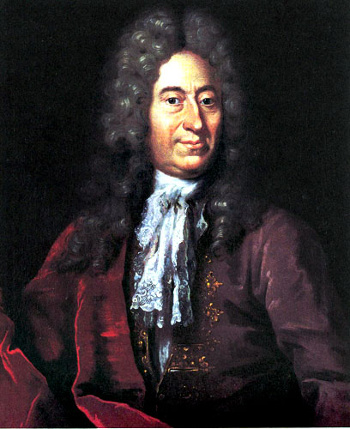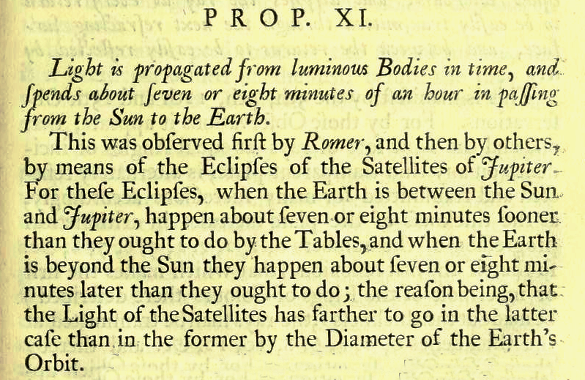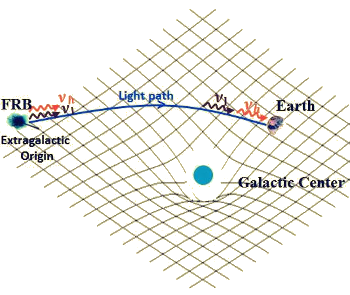Testing Relativity
February 15, 2016
Unlike
sound,
light travels fast enough for
humans to think that
its speed is
infinite. Nearly every
child knows the
trick of counting the
seconds between a
lightning flash and its associated
thunder to estimate the distance to the strike. Since the
speed of sound in
air is about 335
meters per second (1100
feet per second), and a
mile is 5280
feet, then a five second duration is just slightly more than a mile.
From
antiquity to the time when the speed of light was
first observed in the late
17th century by
Ole Rømer,
philosophers argued whether the speed of light was infinite, or just too large to
sense.
Aristotle, who loomed large in early philosophic circles, was of the opinion that the sensation of light was immediate, not because its speed is infinite, but because it's always present, so it doesn't move at all.

Portion of Aristotle's "De Anima" in which he claims that light is a presence that has no movement. (Greek text from "The Little Sailing," by Agelos Perdikouris.)[1])
One popular, but strangely
anthropocentric,
theory of light is that it's emitted from the
eye to enable
sight.
Empedocles,
Euclid,
Ptolemy, and
Heron of Alexandria espoused this theory. Heron reasoned that the speed of light must be infinite, since the distant
stars are seen immediately after opening your eyes.
Roger Bacon (c. 1214 - c. 1292), not to be confused with
Francis Bacon (1561 - 1626), sided with the Aristotelian and Ptolemaic philosophical arguments for a non-finite speed of light in Part V of his
Opus Maius.
Closer to our time, Francis Bacon argued from the
geocentric model of the
universe that the speed of light must be infinite, since the speed of the distant stars revolving around the
Earth on the
sphere of the
fixed stars, must be very great. As he wrote in Aphorism XLVI in Book II of the
Novum Organum,
"Again the immense velocity in the body itself as discerned in its daily motion (which has so astonished certain grave men that they preferred believing that the earth moved) renders this motion of ejaculation of rays therefrom (although wonderful, as I have said, in speed) more easy of belief.[4-5]
Galileo Galilei (1564–1642), a contemporary of Francis Bacon, wrote in his
Two New Sciences (1638) the opinion that the speed of light was finite; but, as the first
experimental physicist, he proposed an
experiment. This experiment, which was performed in 1667 by members of the
Accademia del Cimento of Florence, showed that the speed was too great to discern.
Galileo's experiment was a variation of one performed by
Dutch scientist,
Isaac Beeckman (1588 - 1637). Beeckman placed a
mirror a mile's distance so that the flash of light from an
explosion could be observed immediately and after two miles further travel. No difference could be seen, which is not surprising, since the travel time of light would have been about ten
microseconds.[3]
Johannes Kepler (1571 - 1630) was a believer in an infinite speed of light for the simple reason that
empty space would present no obstacle to its motion.
René Descartes (1596 - 1650) made the
analogy between the transmission of light and pushing on a
stick. He reasoned that a light source "pushing" at one end of the stick would cause an instantaneous "motion" at the other end.[3] This analogy is false, since it reduces to a
tautology.
Mechanical movement will traverse a body at its speed of sound, which, in Descartes' case, would be the speed of light.
Finally, the
Danish astronomer,
Ole Rømer (1644 - 1710), followed-up on the observations of the
eclipses of the
moons of Jupiter done by
Cassini between 1666 and 1668. Cassini found that the times between eclipses were shorter when Earth and
Jupiter were close, and longer when Earth was more distant. Cassini actually attributed the cause to a finite speed of light, and he even estimated how long it takes for light to travel from the
Sun to the Earth. His estimate was about 25% too long.

A c. 1700 portrait of the Danish astronomer, Ole Rømer (1644 - 1710), by Jacob Coning (c. 1647-1724).
Rømer, was a professor of astronomy at the University of Copenhagen, and also the royal mathematician. As part of his duties, he introduced the first system of weights and measures for Denmark in 1683.
(Frederiksborg Museum image, via Wikimedia Commons.)
Rømer, along with his
assistant, Jean Picard, observed eclipses of Jupiter's moons between 1671 and 1677. Although Rømer presented his results to the
French Academy of Sciences, the best available summary of his observations is given in
Newton's Opticks. Newton reported Rømer's value for the speed of light in terms of the transit time of light from the Sun to the Earth. He gave this as 7-8 minutes. The actual value is 8 minutes 19 seconds over the average distance (one
astronomical unit).

The portion of Prop. XI of Newton's Opticks that mentions Rømer's eclipse observations and the imputed travel time of light through the diameter of Earth's orbit. (Via archive.org.)[6])
A team of
astrophysicists from the
Chinese Academy of Sciences (Nanjing, China), the
Beijing Normal University (Beijing, China), the
Nanjing University-Purple Mountain Observatory (Nanjing, China) and
Pennsylvania State University have just used the speed of light as a sensitive test of the
equivalence principle of
general relativity. This principle states that any two
photons of different
frequencies, emitted simultaneously from the same source and traveling through the same
gravitational fields, will arrive at exactly the same time when they reach the Earth.
The simultaneous photons the
research team analyzed were from the
pulsed radio sources known as
Fast Radio Bursts. These infrequent radio pulses are generated at great
cosmological distances, another factor that enhances the
precision of this relativity test. I wrote about Fast Radio Bursts in a
recent article (Cosmic Radio Burst, March 5, 2015).
Fast Radio Bursts are extremely
energetic radio emissions compacted into a pulse lasting just a few
milliseconds. These occur infrequently, and about ten of these have been detected since their first discovery about fifteen years ago. They appear to occur far beyond our
Milky Way Galaxy.

Geometry of the equivalence principle measurement. Two photons, at frequencies νh and νl travel through the gravitational well at the center of our Milky Way Galaxy before reaching Earth.
(Purple Mountain Observatory, Chinese Academy of Sciences, image, via Penn State University.)
Senior
author of the study and
professor of astrophysics at Penn State,
Peter Mészáros, says that the team's data "supersedes by one to two
orders of magnitude the previous best limits on the accuracy of the
Einstein Equivalence Principle." The previous measurement was based on radiation from
supernova 1987A. Says Mészáros,
"Our analysis using radio frequencies shows that the Einstein Equivalence Principle is obeyed to one part in a hundred million... This result is a significant tribute to Einstein's theory, on the hundredth anniversary of its first formulation."[7-8]
By measuring the delay between photons received at 1.23 GHz and 1.45
GHz, the research team was able to calculate a
parameter, called gamma (γ), that appears in the
Parameterized post-Newtonian formalism that expresses Einstein's equations. The difference in gamma value at these frequencies was less than, or equal to, 4.36x10
-9.[7] This research was supported by
NASA and several
Chinese organizations.[8]
References:
- Aristotle, "De Anima (On the soul)," in The Complete Works of Aristotle: The Revised Oxford Translation, J. Barnes, ed., J.A. Smith, trans., Princeton Univ. Press (1984), vol. 1, pp. 641-692.
- Αριστοτελους, "Περι Ψυχης," Greek text via mikrosapoplous.gr.
- R. J. MacKay and R. W. Oldford, "Scientific Method, Statistical Method and the Speed of Light," Statistical Science, vol. 15, no. 3 (2000), pp. 254-278.
- Novum Organum by Francis Bacon, Spedding, Ellis, and Heath, eds.. James Spedding et al., trans., Book II, Instauratio Magna, 1858.
- Latin text via the Latin Library, "Etiam immensa illa velocitas in ipso corpore, quae cernitur in motu diurno (quae etiam viros graves ita obstupefecit ut mallent credere motum terrae), facit motum illum ejaculationis radiorum ab ipsis (licet celeritate, ut diximus, mirabilem) magis credibilem."
- Isaac Newton, "Opticks: or, A Treatise of the Reflexions, Refractions, Inflexions and Colours of Light; Also Two Treatises of the Species and Magnitude of Curvilinear Figures," (Samuel Smith and Benjamin Walford: London 1704), first edition, Prop. XI, p. 77, via archive.org.
- Jun-Jie Wei, He Gao, Xue-Feng Wu, and Peter Mészáros, "Testing Einstein's Equivalence Principle With Fast Radio Bursts," Phys. Rev. Lett., vol. 115, no. 26 (December 31, 2015), Document no. 261101, DOI: 10.1103/PhysRevLett.115.261101.
- Barbara Kennedy, "Mysterious radio signals from space are much better test of Einstein's General Relativity," Penn State University Press Release, December 30, 2015.
Permanent Link to this article
Linked Keywords: Sound; light; humans; speed of light; infinity; infinite; child; methodology; trick; second; lightning flash; thunder; speed of sound; air; meters per second; feet per second; mile; foot; Ancient Greece; antiquity; Roemer's determination of the speed of light; 17th century; Ole Rømer; philosopher; sense; Aristotle; On the Soul; De Anima; Greek language; "The Little Sailing," by Agelos Perdikouris; anthropocentrism; anthropocentric; theory; human eye; sense; sight; Empedocles; Euclid; Ptolemy; Heron of Alexandria; star; Roger Bacon (c. 1214 - c. 1292); Francis Bacon (1561 - 1626); Opus Majus; Opus Maius; geocentric model; universe; Earth; celestial sphere; fixed stars; Novum Organum; Galileo Galilei (1564–1642); Two New Sciences (1638); experimental physics; experimental physicist; experiment; Accademia del Cimento of Florence; Dutch; scientist; Isaac Beeckman (1588 - 1637); mirror; explosion; microsecond; Johannes Kepler (1571 - 1630); vacuum; empty space; René Descartes (1596 - 1650); analogy; stick; tautology; classical mechanics; Danish; astronomer; eclipse; moons of Jupiter; Giovanni Domenico Cassini; Jupiter; Sun; Jacob Coning (c. 1647-1724); professor; astronomy; University of Copenhagen; royal; mathematician; weights and measures; Frederiksborg Museum; Wikimedia Commons; technician; assistant; French Academy of Sciences; Isaac Newton; Opticks; astronomical unit; Earth's orbit; archive.org; astrophysics; astrophysicist; Chinese Academy of Sciences (Nanjing, China); Beijing Normal University (Beijing, China); Nanjing University-Purple Mountain Observatory (Nanjing, China); Pennsylvania State University; equivalence principle; general relativity; photon; frequency; gravitational field; research; pulse; radio frequency; Fast Radio Bursts; cosmological; precision; energetic; millisecond; Milky Way Galaxy; Geometry; gravitational well; author; professor; Peter Mészáros; orders of magnitude; Einstein Equivalence Principle; supernova 1987A; anniversary; GHz; parameter; Parameterized post-Newtonian formalism; NASA; Chinese.